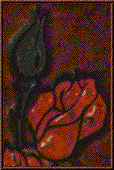![]() More Info
More Info
![]()
 You can check out my work for some examples, but if you have never seen a piece of hand-tooled, hand-crafted
leather, you might be in for a surprise. Generally speaking, tooling
leather is a lot thicker than garment leather or purse/wallet
leather. This is because it is split from the hide in order to be
cut into and shaped with tools. The actual thickness of the tooling
leather can vary from about 1/16" all the way past 1/4" thick!
Because of this extra thickness it is also a great deal more durable
and long lasting than the thin, machine sewn leather used to make
modern wallets and purses. Also, modern wallet leathers are
popularly what I call "pressed leather". Manufacturers take leather
fibers and press them with adhesives to make a new sheet of
"leather" much like inexpensive bookshelves are made with particle
board that is nothing more than sawdust and glue. The thick, tooling
leather is almost always only used on the outer parts of an article.
A clutch purse, for example will have a tooled leather exterior
(about 1/8" thick) with a design literally carved into the surface
(much like the rubber part of an ink stamp), and an interior made
from thinner "lining" leathers which are thinner than the tooling
leather but usually a little thicker, and hence more durable, than
what you find in stores.
You can check out my work for some examples, but if you have never seen a piece of hand-tooled, hand-crafted
leather, you might be in for a surprise. Generally speaking, tooling
leather is a lot thicker than garment leather or purse/wallet
leather. This is because it is split from the hide in order to be
cut into and shaped with tools. The actual thickness of the tooling
leather can vary from about 1/16" all the way past 1/4" thick!
Because of this extra thickness it is also a great deal more durable
and long lasting than the thin, machine sewn leather used to make
modern wallets and purses. Also, modern wallet leathers are
popularly what I call "pressed leather". Manufacturers take leather
fibers and press them with adhesives to make a new sheet of
"leather" much like inexpensive bookshelves are made with particle
board that is nothing more than sawdust and glue. The thick, tooling
leather is almost always only used on the outer parts of an article.
A clutch purse, for example will have a tooled leather exterior
(about 1/8" thick) with a design literally carved into the surface
(much like the rubber part of an ink stamp), and an interior made
from thinner "lining" leathers which are thinner than the tooling
leather but usually a little thicker, and hence more durable, than
what you find in stores.
Any piece that has multiple parts that need to be sewn together
will be assembled using one or more of three techniques. For the
thinner interior pieces, they are sewn by hand using a professional
leather sewing machine (used for shoe repair). This process is
always reserved for assembling thin pieces to each other. The next
technique of assembly is the saddle stitch.  This is done with a
waxed thread and two needles weaving their way through the seam to
be stitched. This results in a strong, tight stitch between two or
more pieces of leather, no matter how thick they are. It's called a
saddle stitch because it's the same one used to assemble, you
guessed it, saddles! Now you KNOW it's strong! The third technique
is the most decorative and possibly the strongest: Leather Lacing.
This is done with a
waxed thread and two needles weaving their way through the seam to
be stitched. This results in a strong, tight stitch between two or
more pieces of leather, no matter how thick they are. It's called a
saddle stitch because it's the same one used to assemble, you
guessed it, saddles! Now you KNOW it's strong! The third technique
is the most decorative and possibly the strongest: Leather Lacing. This stitch is done by lacing a thin strip of leather through and
around holes punched in the leather. It is used primarily to
attach interior parts to the exterior tooled leather. There are many
styles of lacing ranging from a simple running stitch that is no
more than a single lace weaving through the holes, to the complex
"Mexican Basketweave" stitch too complex for words to describe.
This stitch is done by lacing a thin strip of leather through and
around holes punched in the leather. It is used primarily to
attach interior parts to the exterior tooled leather. There are many
styles of lacing ranging from a simple running stitch that is no
more than a single lace weaving through the holes, to the complex
"Mexican Basketweave" stitch too complex for words to describe.
I have seen a lot of really old leatherwork and, even with some seams coming loose (results of extreme wear), they are still quite sturdy and durable. Virtually the only way a good leather wallet or purse, etc. will come apart is with a sharp knife!
Feel free to go to my shop to see what kinds of tools I use to make my leather project, and learn about them at the same time!